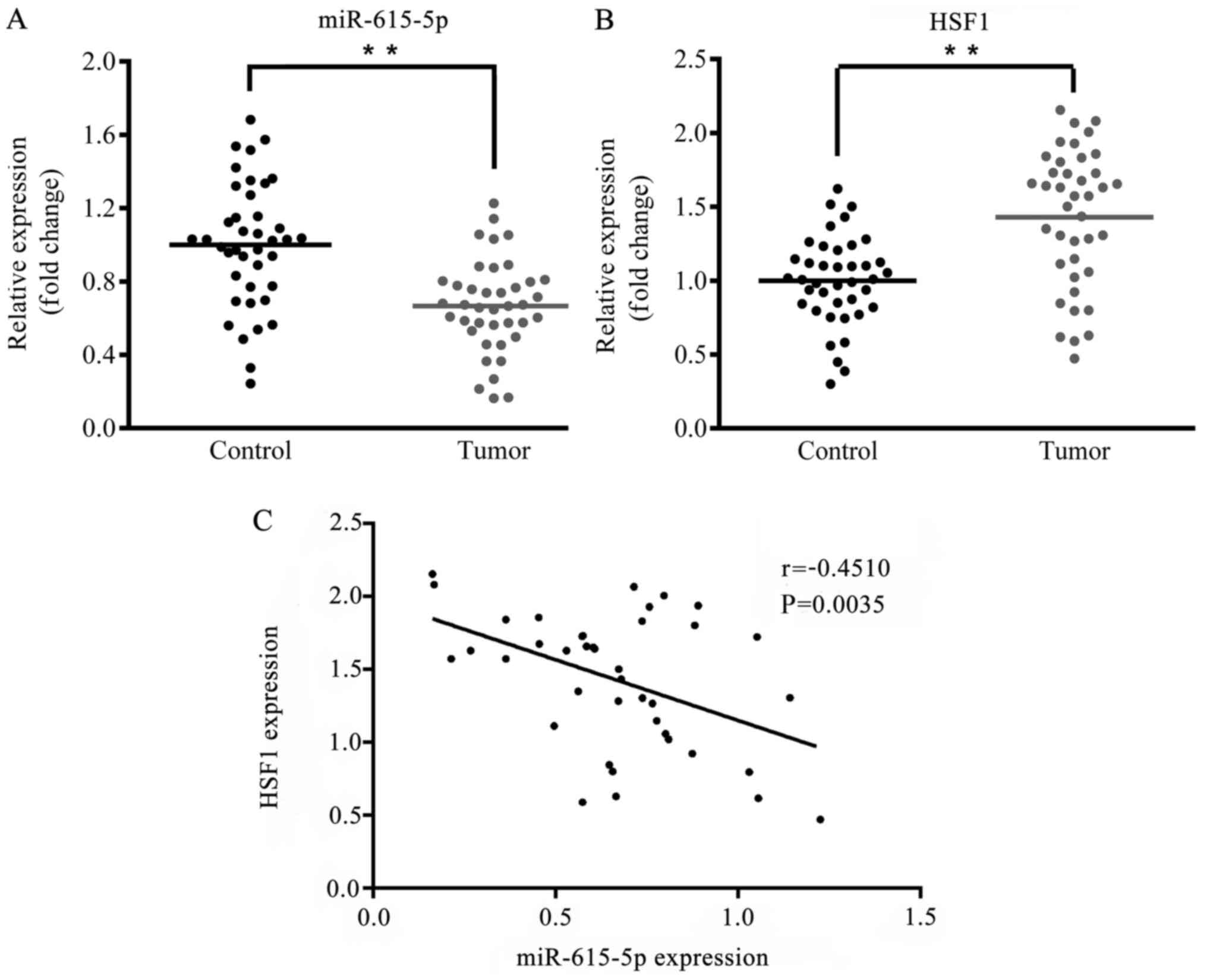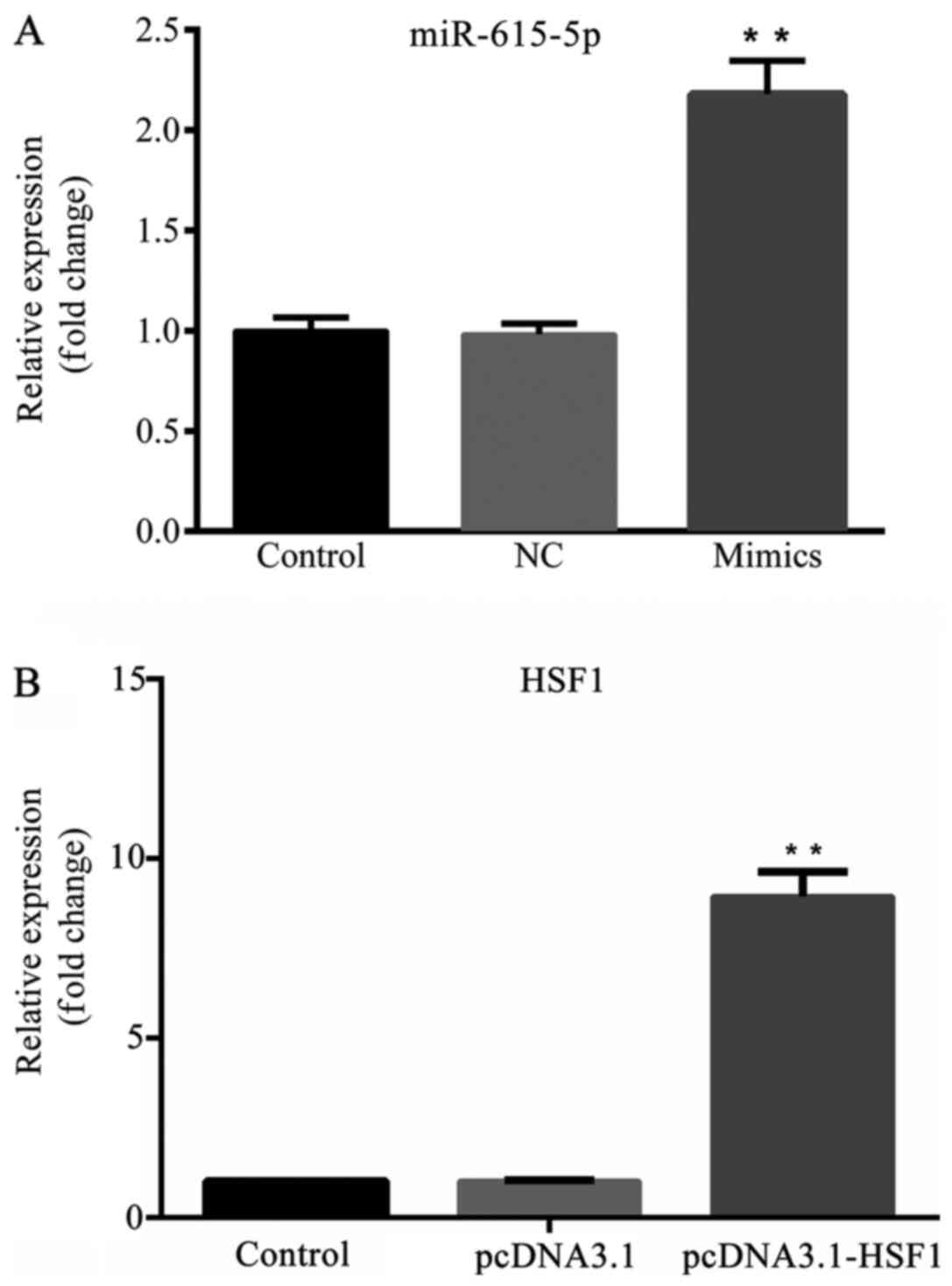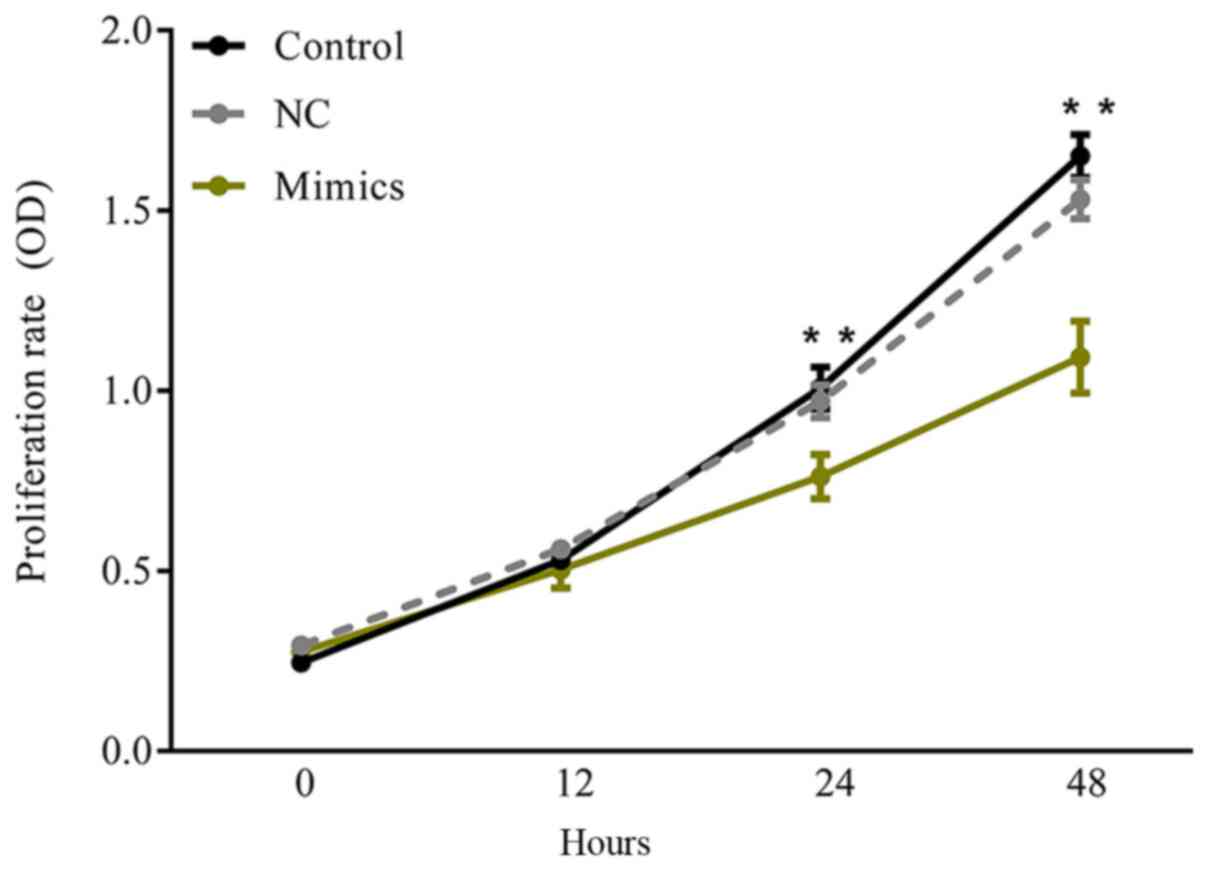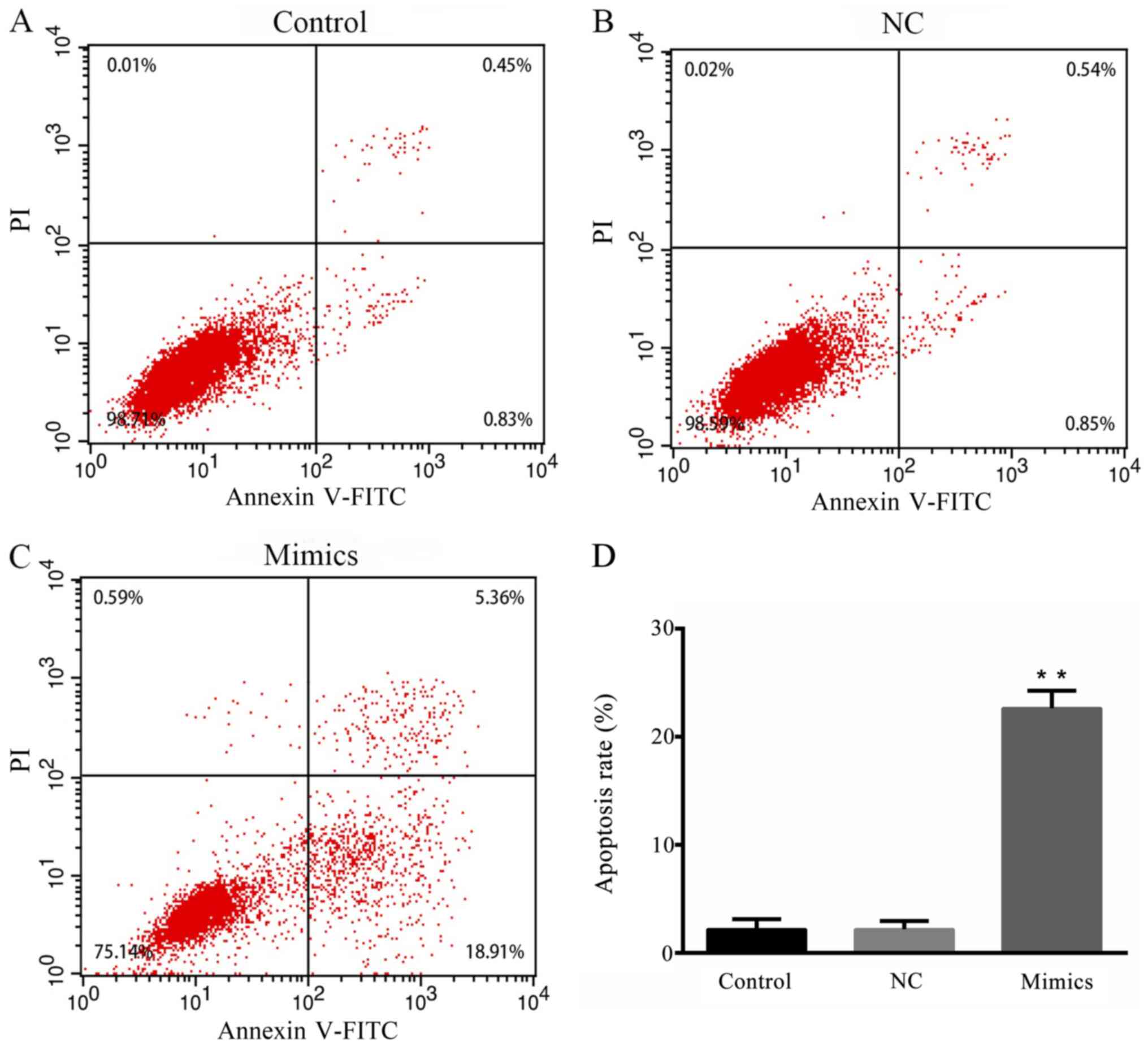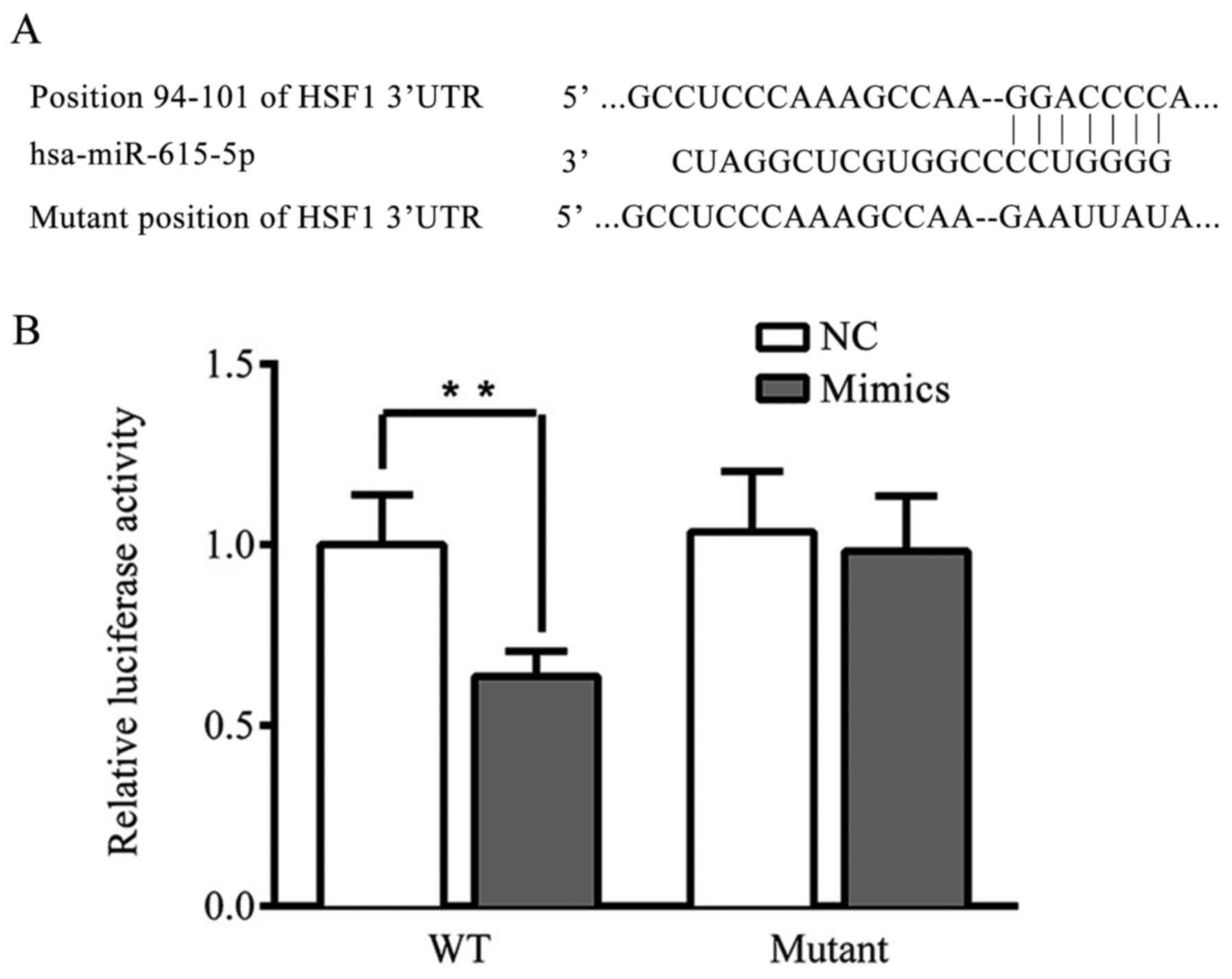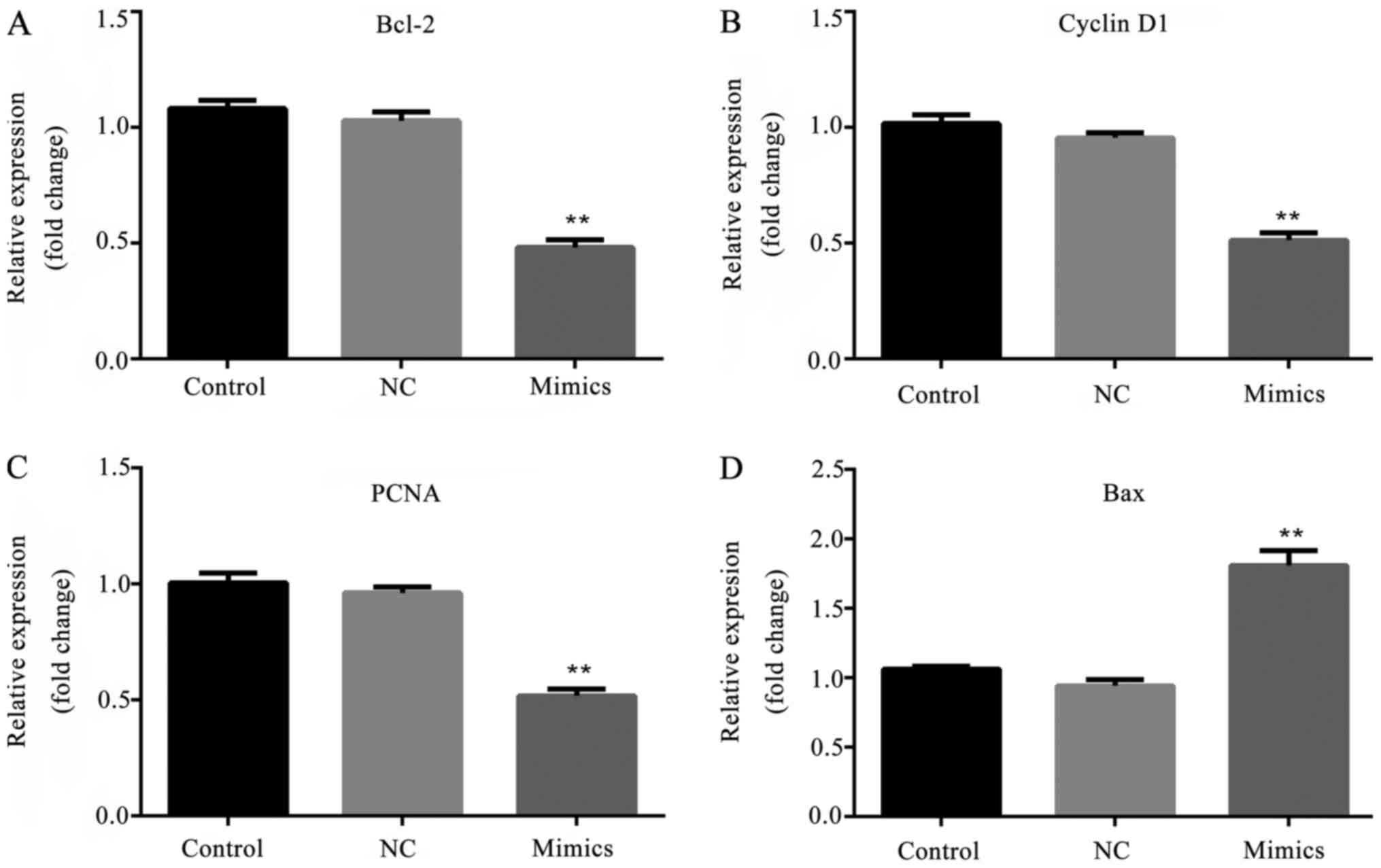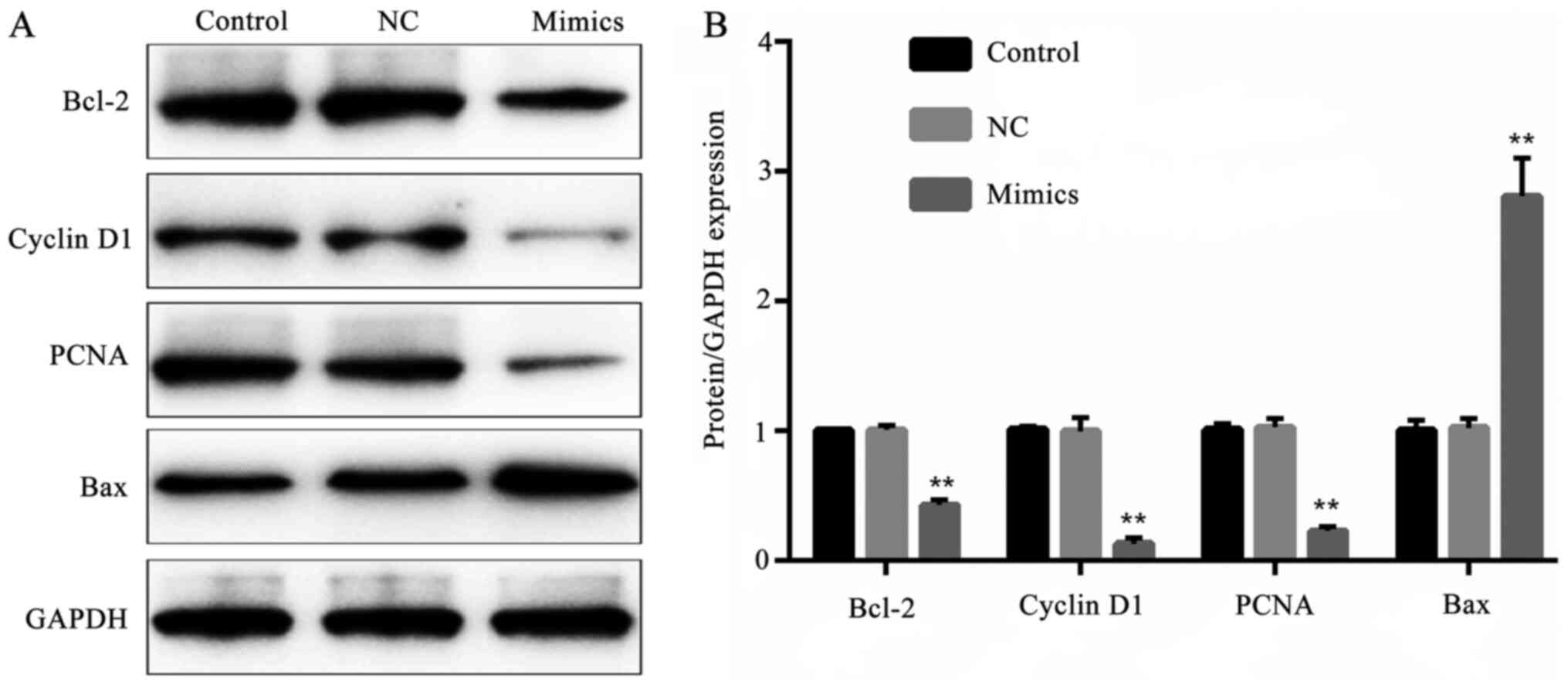|
1
|
Torre LA, Bray F, Siegel RL, Ferlay J,
Lortet-Tieulent J and Jemal A: Global cancer statistics, 2012. CA
Cancer J Clin. 65:87–108. 2015.PubMed/NCBI View Article : Google Scholar
|
|
2
|
Hesari A, Azizian M, Darabi H, Nesaei A,
Hosseini SA, Salarinia R, Motaghi AA and Ghasemi F: Expression of
circulating miR-17, miR-25, and miR-133 in breast cancer patients.
J Cell Biochem, Nov 28, 2018 (Epub ahead of print). doi:
10.1002/jcb.27984.
|
|
3
|
Farazi TA, Hoell JI, Morozov P and Tuschl
T: MicroRNAs in human cancer. Adv Exp Med Biol. 774:1–20.
2013.PubMed/NCBI View Article : Google Scholar
|
|
4
|
Dalmay T: Mechanism of miRNA-mediated
repression of mRNA translation. Essays Biochem. 54:29–38.
2013.PubMed/NCBI View Article : Google Scholar
|
|
5
|
Ji CZ, Han SH and Xing YF: Overexpression
of miR-3196 suppresses cell proliferation and induces cell
apoptosis through targeting ERBB3 in breast cancer. Eur Rev Med
Pharmacol Sci. 22:8383–8390. 2018.PubMed/NCBI View Article : Google Scholar
|
|
6
|
Lu K, Wang J, Song Y, Zhao S, Liu H, Tang
D, Pan B, Zhao H and Zhang Q: miRNA-24-3p promotes cell
proliferation and inhibits apoptosis in human breast cancer by
targeting p27Kip1. Oncol Rep. 34:995–1002. 2015.PubMed/NCBI View Article : Google Scholar
|
|
7
|
Bai Y, Li JY, Li J, Liu YH and Zhang B:
miR-615 inhibited cell proliferation and cell cycle of human breast
cancer cells by suppressing of AKT2 expression. Int J Clin Exp Med.
8:3801–3808. 2015.PubMed/NCBI
|
|
8
|
Dong Y, Huo X, Sun R, Liu Z, Huang M and
Yang S: lncRNA Gm15290 promotes cell proliferation and invasion in
lung cancer through directly interacting with and suppressing the
tumor suppressor miR-615-5p. Biosci Rep. 38:
pii(BSR20181150)2018.PubMed/NCBI View Article : Google Scholar
|
|
9
|
Sun Y, Zhang T, Wang C, Jin X, Jia C, Yu S
and Chen J: miRNA-615-5p functions as a tumor suppressor in
pancreatic ductal adenocarcinoma by targeting AKT2. PLoS One.
10(e0119783)2015.PubMed/NCBI View Article : Google Scholar
|
|
10
|
Livak KJ and Schmittgen TD: Analysis of
relative gene expression data using real-time quantitative PCR and
the 2(-Delta Delta C(T)) method. Methods. 25:402–408.
2001.PubMed/NCBI View Article : Google Scholar
|
|
11
|
Agarwal V, Bell GW, Nam JW and Bartel DP:
Predicting effective microRNA target sites in mammalian mRNAs.
Elife. 4:2015.PubMed/NCBI View Article : Google Scholar
|
|
12
|
Pu HY, Xu R, Zhang MY, Yuan LJ, Hu JY,
Huang GL and Wang HY: Identification of microRNA-615-3p as a novel
tumor suppressor in non-small cell lung cancer. Oncol Lett.
13:2403–2410. 2017.PubMed/NCBI View Article : Google Scholar
|
|
13
|
Asano Y, Kawase T, Okabe A, Tsutsumi S,
Ichikawa H, Tatebe S, Kitabayashi I, Tashiro F, Namiki H, Kondo T,
et al: IER5 generates a novel hypo-phosphorylated active form of
HSF1 and contributes to tumorigenesis. Sci Rep.
6(19174)2016.PubMed/NCBI View Article : Google Scholar
|
|
14
|
Gao W, Gu Y, Li Z, Cai H, Peng Q, Tu M,
Kondo Y, Shinjo K, Zhu Y, Zhang J, et al: miR-615-5p is
epigenetically inactivated and functions as a tumor suppressor in
pancreatic ductal adenocarcinoma. Oncogene. 34:1629–1640.
2015.PubMed/NCBI View Article : Google Scholar
|
|
15
|
Huang FY, Zhao HJ, Du ZJ and Jiang H:
miR-615 inhibits prostate cancer cell proliferation and invasion by
directly targeting Cyclin D2. Oncol Res. 27:293–299.
2019.PubMed/NCBI View Article : Google Scholar
|
|
16
|
Naresh DJ and Nadav B: Reconstruction of
temporal activity of microRNAs from gene expression data in breast
cancer cell line. BMC Genomics. 16(1077)2015.PubMed/NCBI View Article : Google Scholar
|
|
17
|
Fang F, Chang R and Yang L: Heat shock
factor 1 promotes invasion and metastasis of hepatocellular
carcinoma in vitro and in vivo. Cancer. 118:1782–1794.
2012.PubMed/NCBI View Article : Google Scholar
|
|
18
|
Cen H, Zheng S, Fang YM, Tang XP and Dong
Q: Induction of HSF1 expression is associated with sporadic
colorectal cancer. World J Gastroenterol. 10:3122–3126.
2004.PubMed/NCBI View Article : Google Scholar
|
|
19
|
Santagata S, Hu R, Lin NU, Mendillo ML,
Collins LC, Hankinson SE, Schnitt SJ, Whitesell L, Tamimi RM,
Lindquist S and Ince TA: High levels of nuclear heat-shock factor 1
(HSF1) are associated with poor prognosis in breast cancer. Proc
Natl Acad Sci USA. 108:18378–18383. 2011.PubMed/NCBI View Article : Google Scholar
|
|
20
|
Chen FY, Dong Z, Xia Y, Tang J, Peng L,
Wang S and Lai D: Nucleoside analog inhibits microRNA-214 through
targeting heat-shock factor 1 in human epithelial ovarian cancer.
Cancer Sci. 104:1683–1689. 2013.PubMed/NCBI View Article : Google Scholar
|
|
21
|
Dai C, Santagata S, Tang Z, Shi J, Cao J,
Kwon H, Bronson RT, Whitesell L and Lindquist S: Loss of tumor
suppressor NF1 activates HSF1 to promote carcinogenesis. J Clin
Invest. 122:3742–3745. 2012.PubMed/NCBI View
Article : Google Scholar
|
|
22
|
Heimberger T, Andrulis M, Riedel S,
Stühmer T, Schraud H, Beilhack A, Bumm T, Bogen B, Einsele H,
Bargou RC and Chatterjee M: The heat shock transcription factor 1
as a potential new therapeutic target in multiple myeloma. Br J
Haematol. 160:465–476. 2013.PubMed/NCBI View Article : Google Scholar
|
|
23
|
Ishiwata J, Kasamatsu A, Sakuma K, Iyoda
M, Yamatoji M, Usukura K, Ishige S, Shimizu T, Yamano Y, Ogawara K,
et al: State of heat shock factor 1 expression as a putative
diagnostic marker for oral squamous cell carcinoma. Int J Oncol.
40:47–52. 2012.PubMed/NCBI View Article : Google Scholar
|
|
24
|
Hoang AT, Huang J, Rudra-Ganguly N, Zheng
J, Powell WC, Rabindran SK, Wu C and Roy P: A novel association
between the human heat shock transcription factor 1 (HSF1) and
prostate adenocarcinoma. Am J Pathol. 156:857–864. 2000.PubMed/NCBI View Article : Google Scholar
|
|
25
|
Miyachi K, Fritzler MJ and Tan EM:
Autoantibody to a nuclear antigen in proliferation cells. J
Immunol. 121:2228–2234. 1978.PubMed/NCBI
|
|
26
|
Liao XH, Lu DL, Wang N, Liu LY, Wang Y, Li
YQ, Yan TB, Sun XG, Hu P and Zhang TC: Estrogen receptor α mediates
proliferation of breast cancer MCF-7 cells via a
p21/PCNA/E2F1-dependent pathway. FEBS J. 281:927–942.
2014.PubMed/NCBI View Article : Google Scholar
|
|
27
|
Li T, Zhang C, Ding Y, Zhai W, Liu K, Bu
F, Tu T, Sun L, Zhu W, Zhou F, et al: Umbilical cord-derived
mesenchymal stem cells promote proliferation and migration in MCF-7
and MDA-MB-231 breast cancer cells through activation of the ERK
pathway. Oncol Rep. 34:1469–1477. 2015.PubMed/NCBI View Article : Google Scholar
|
|
28
|
Wu J, Li H, Wang X, Zhang X, Liu W, Wang
Y, Zhang Y, Pan H, Wang Q and Han Y: Effect of polysaccharide from
Undaria pinnatifida on proliferation, migration and apoptosis of
breast cancer cell MCF7. Int J Biol Macromol. 121:734–742.
2019.PubMed/NCBI View Article : Google Scholar
|
|
29
|
Min JN, Huang L, Zimonjic DB, Moskophidis
D and Mivechi NF: Selective suppression of lymphomas by functional
loss of Hsf1 in a p53-deficient mouse model for spontaneous tumors.
Oncogene. 26:5086–5097. 2007.PubMed/NCBI View Article : Google Scholar
|
|
30
|
Diehl JA: Cycling to cancer with cyclin
D1. Cancer Biol Ther. 1:226–231. 2002.PubMed/NCBI View
Article : Google Scholar
|
|
31
|
He Y, Liu Z, Qiao C, Xu M, Yu J and Li G:
Expression and significance of Wnt signaling components and their
target genes in breast carcinoma. Mol Med Rep. 9:137–143.
2014.PubMed/NCBI View Article : Google Scholar
|
|
32
|
Qin H and Liu W: MicroRNA-99a-5p
suppresses breast cancer progression and cell-cycle pathway through
downregulating CDC25A. J Cell Physiol. 234:3526–3537.
2019.PubMed/NCBI View Article : Google Scholar
|
|
33
|
Song X, Wu JQ, Yu XF, Yang XS and Yang Y:
Trichostatin A inhibits proliferation of triple negative breast
cancer cells by inducing cell cycle arrest and apoptosis.
Neoplasma. 65:898–906. 2018.PubMed/NCBI View Article : Google Scholar
|
|
34
|
Chi Y, Xu H, Wang F, Chen X, Shan Z, Sun Y
and Fan Q: ZKSCAN3 promotes breast cancer cell proliferation,
migration and invasion. Biochem Biophys Res Commun. 503:2583–2589.
2018.PubMed/NCBI View Article : Google Scholar
|
|
35
|
Sawai M, Ishikawa Y, Ota A and Sakurai H:
The proto-oncogene JUN is a target of the heat shock transcription
factor HSF1. FEBS J. 280:6672–6680. 2013.PubMed/NCBI View Article : Google Scholar
|
|
36
|
Escórcio-Dourado CS, Martins LM,
Simplício-Revoredo CM, Sampaio FA, Tavares CB, da Silva-Sampaio JP,
Borges US, Alves-Ribeiro FA, Lopes-Costa PV, Lima-Dourado JC and da
Silva BB: Bcl-2 antigen expression in luminal A and triple-negative
breast cancer. Med Oncol. 34(161)2017.PubMed/NCBI View Article : Google Scholar
|
|
37
|
Kallel-Bayoundh I, Hassen HB, Khabir A,
Boujelbene N, Daoud J, Frikha M, Sallemi-Boundawara T, Aifa S and
Rebai A: Bcl-2 expression and triple negative profile in breast
carcinoma. Med Oncol. 28 (Suppl 1):S55–S61. 2001.PubMed/NCBI View Article : Google Scholar
|
|
38
|
de Ruijter TC, Veeck J, de Hoon JP, van
Engeland M and Tjan-Heijnen VC: Characteristics of triple-negative
breast cancer. J Cancer Res Clin Oncol. 137:183–192.
2011.PubMed/NCBI View Article : Google Scholar
|
|
39
|
Wang X, Zhang D, Cao M, Ba J, Wu B, Liu T
and Nie C: A study on the biological function of heat shock factor
1 proteins in breast cancer. Oncol Lett. 16:3821–3825.
2018.PubMed/NCBI View Article : Google Scholar
|
|
40
|
Du L, Fei Z, Song S and Wei N: Antitumor
activity of Lobaplatin against esophageal squamous cell carcinoma
through caspase-dependent apoptosis and increasing the Bax/Bcl-2
ratio. Biomed Pharmacother. 95:447–452. 2017.PubMed/NCBI View Article : Google Scholar
|
|
41
|
Yang F, Yu Y, Lei Q, Zeng A, Li Y, Xie Y,
Ye T and Wei Y: Lobaplatin arrests cell cycle progression, induces
apoptosis and impairs migration and invasion in B16-F10 melanoma
cell line in vitro. Biomed Pharmacother. 69:402–408.
2015.PubMed/NCBI View Article : Google Scholar
|
|
42
|
Lapierre M, Linares A, Dalvai M,
Duraffourd C, Bonnet S, Boulahtouf A, Rodriguez C, Jalaquier S,
Assou S, Orsetti B, et al: Histone deacetylase 9 regulates breast
cancer cell proliferation and the response to histone deacetylase
inhibitors. Oncotarget. 7:19693–19708. 2016.PubMed/NCBI View Article : Google Scholar
|
|
43
|
Quisbert-Valenzuela EO and Calaf GM:
Apoptotic effect of noscapine in breast cancer cell lines. Int J
Oncol. 48:2666–2674. 2016.PubMed/NCBI View Article : Google Scholar
|
|
44
|
Lou Q, Hu Y, Ma Y and Dong Z: Heat shock
factor 1 induces crystallin-αB to protect against cisplatin
nephrotoxicity. Am J Physiol Renal Physiol. 311:F94–F102.
2016.PubMed/NCBI View Article : Google Scholar
|
|
45
|
Jiang Y, Zhang Y, Li F, Du X and Zhang J:
CDX2 inhibits pancreatic adenocarcinoma cell proliferation via
promoting tumor suppressor miR-615-5p. Tumor Biol. 37:1041–1049.
2016.PubMed/NCBI View Article : Google Scholar
|
|
46
|
Song LJ, Zhang WJ, Chang ZW, Pan YF, Zong
H, Fan QX and Wang LX: PU. 1 is identified as a novel metastasis
suppressor in hepatocellular carcinoma regulating the
miR-615-5p/IGF2 axis. Asian Pac J Cancer Prev. 16:3667–3671.
2015.PubMed/NCBI View Article : Google Scholar
|
|
47
|
Shetty PJ, Movva S, Pasupuleti N,
Vedicherlla B, Vattam KK, Venkatasubramaniam S, Ahuja YR and Hasan
Q: Regulation of IGF2 transcript and protein expression by altered
methylation in breast cancer. J Cancer Res Clin Oncol. 137:339–345.
2011.PubMed/NCBI View Article : Google Scholar
|
|
48
|
Schulz R, Streller F, Scheel AH, Rüschoff
J, Reinert MC, Dobbelstein M, Marchenko ND and Moll UM: HER2/ErbB2
activates HSF1 and thereby controls HSP90 clients including MIF in
HER2-overexpressing breast cancer. Cell Death Dis.
5(e980)2014.PubMed/NCBI View Article : Google Scholar
|
|
49
|
Guettouche T, Boellmann F, Lane WS and
Voellmy R: Analysis of phosphorylation of human heat shock factor 1
in cells experiencing a stress. BMC Biochem. 6(4)2005.PubMed/NCBI View Article : Google Scholar
|















